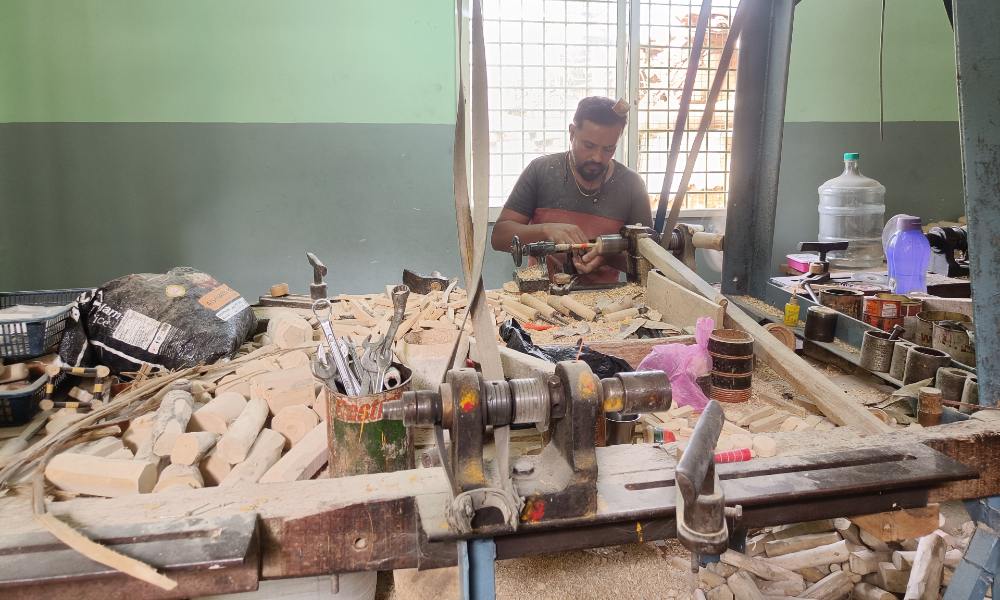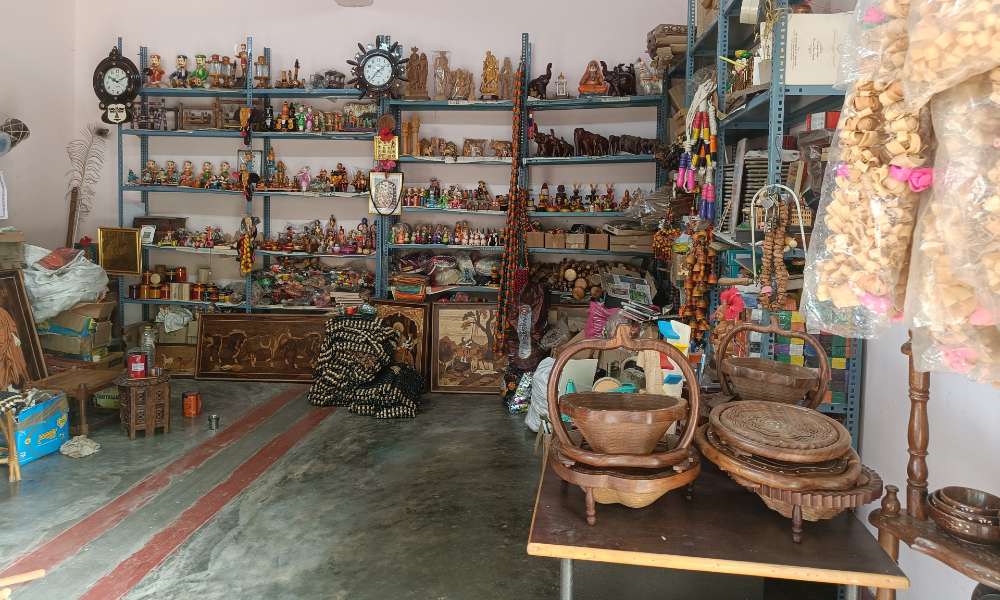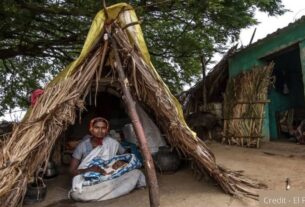Criteria of government schemes and programs not artisan friendly, say Channapatna toy makers
It was a silent day. Krishna Singh, a toy maker in Channapatna was carefully painting the wooden spinning top in his shop surrounded by colorful toys. The sound of an auto pierced the silence. As a customer entered the shop, Krishna’s face lit up.
Lack of information and support, and lack of artisan-friendly programs are affecting the toy makers of Channapatna, whose livelihood is dependent on the craft.
Krishna Singh said that he never got any support from the government. “No one is providing any support for us from the governments end” said Krishna, who followed his father and grandfather in toy making.
Krishna is concerned by the thought that the craft of making Channapatna toys might die soon. “The government should start a course for Channapatna handicrafts in college, so that younger generations can continue the lap by taking the baton,” Krishna said.
Vivek, a toy factory owner in Channapatna stressed on the importance of making the policies and schemes people-friendly for artisans to access them. “Not every program of any government will reach every artist. Moreover, the criteria for the program are not friendly for the artisans,” he said.
Vivek added that because of the norms and conditions, exporting toys is a challenge, “Exporting toys is a big task for every artisan here. Obviously the situation is improving. But not every artisan can do that due to of the lack of information.”
Indian toy makers received huge orders in the Nuremberg International Toy Fair held in Germany from Jan 30 to Feb 3 this year. Indian Toy Maker’s Association confirmed that Channapatna toys were not showcased among them.
Channapatna toys were given Geographical Indication tags (GI tags) in 2005 under the World Trade Organization (WTO).
The steps taken by government to provide support to the domestic toy industry increased the exports of toys by 61.38% from 2018-19 to 2021-22. But the toy makers in Channapatna are awaiting government support.
Mainak Mandal, manager, development, Karnataka handicraft department said that they give training and organize exhibitions for selected artisans. “Schemes are not for individual artisans. We put up notification for the interested artisans. Usually we select state awardee and national awardee. They’ll go and showcase their craft,” he said.
He said that as of now there is no separate scheme for the Channapatna toy makers in Karnataka. We relocated artisans in one particular place to give them facilities. The Karnataka handicraft department has created 13 craft complexes around Karnataka to give training for all handicrafts, one of which is Channapatna toys. “When they are scattered, we cannot facilitate these schemes. So, wherever there is concentration of artisans, we’ve created a craft complex,” he said. He added that they build them houses or Living come Workspace (LCW).
Mandal said that some of the crafts will get subsidized raw materials. “Channapatna toy makers don’t get it, since raw materials are easily available,” he said.
One of the challenges faced by the artisans is the preference of Chinese plastic toys over the traditional environment-friendly toys.
Krishna said that the color used for making Channapatna toys is organic. They are extracted from vegetables. With less or no toxic materials, these wooden toys are safer for children. “Chinese toys don’t have the authenticity of Channapatna toys,” he said.
Chitti Pantulu, Aequs Private Limited company, which is a wholesaler, manufacturer, testing and exporter of toys said that the company makes toys for global brands and is mostly into plastic and electronic toys. “As part of community relations and Corporate Social Responsibility (CSR), the company is supporting Kinnal toys,” he said. Kinnal toys, made of lightweight wood are GI tagged as well.

A study published on May 2018, comparing the Chinese toys and Channapatna toys, “A Comprehensive Life-Cycle Assessment of Locally Oriented Small-Scale Toy Industries: A Study of traditional Channapatna Toys as Against low cost PVC (Poly-Vinyl Chloride) Toys made in China,” pointed out the positive environmental impacts of Channapatna toys over Chinese toys. The Channapatna toys have no toxic chemicals, unlike the plastic Chinese toys.
Dr. Yadu C R, Assistant Professor of Economics at RV University said that government should prioritize the industry, given its significance. “Unlike many other traditional manufacturing sectors, Channapatna toys hold a distinct advantage as they are GI tagged. Therefore, the state government must prioritize efforts to secure both domestic and international markets for these products. This is crucial not only for their economic significance in sustaining households but also as a gesture of safeguarding culturally embedded industries,” he said.
“Gombegala Ooru,” or the “Toy City” in Ramanagara district in Karnataka, has received less footfall ever since the inauguration of the Bengaluru-Mysuru Expressway, according to reports. This added to the already existing list of challenges faced by the artisans.
Vikram Bhat, an urban planner suggested that more active efforts could be made from the government to promote and keep the traditional arts from dying. He stressed on the importance of funding. “Government should step in and support the craftsmen and artisans of Channapatna. Monthly funding or monthly allowance should be given to the artisans, so that their livelihood is not lost.”
Better advertising and marketing might also help the artisans. He said that small initiatives, crowd funding and reserving places for these art works in Shopping malls would help them.
“Schools could invite artists to display these toys, to familiarize them to the children. Create interest and create the curiosity in children,” he said.



